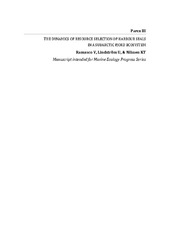| dc.contributor.advisor | Haug, Tore | |
| dc.contributor.author | Ramasco, Virginie | |
| dc.date.accessioned | 2015-09-29T08:00:59Z | |
| dc.date.available | 2015-09-29T08:00:59Z | |
| dc.date.issued | 2015-09-24 | |
| dc.description.abstract | The coastal cod stock of the Porsangerfjord has drastically declined in the
80’s and never fully recovered since. A population of harbour seals, known to be
resident in the fjord all year round, has been hypothesised to act as predator-pit
for cod in the area, affecting its lack of recovery. In order to understand the role of
these seals in this local marine ecosystem, their foraging behaviour was
investigated by assessing the presence of preference for certain prey and the
behavioural response to the seasonal dynamics of prey distribution in the fjord.
The movement patterns of individual harbour seals (n = 15) were followed
between 2009 and 2013. The data obtained (i.e. GPS location, time-depth dive
profiles, etc.) were first thoroughly analysed to provide a robust interpretation of
the behavioural patterns of activities of the single individuals and identify the
methodological caveats in the detection of foraging behaviour. Among the major
results, two types of resting behaviour at sea were described, in the form of
prolonged periods at surface but also as resting dives, a behaviour never
documented before for this species. The patterns of activity suggested that harbour
seals mainly forage during daylight in autumn and spring in this area.
The foraging locations identified were then compared to the availability of
potential prey in the fjord (i.e. herring, capelin, small and large codfish and
sculpins). The availability of prey was assumed to be dependent on their biomass
densities, their distance from the seals’ haulout sites and the accessibility of the
areas where prey was located. The latter could be restricted for example by the
presence of sea ice in winter and spring. Results on the analyses of prey selection
suggested that harbour seals in Porsangerfjord had a preference for small size fish
(< 25cm). Small codfish was preferred during autumn, but a response to the
presence of pelagic fish was seen when the latter aggregated to overwinter in cold
deep waters in the inner parts of the fjord. The formation of ice in these areas
during the winter season, however, provoked a shift in preference to small codfish,
due to the sudden inaccessibility of the pelagic fish. A strong reversed trend was
observed in late spring when the ice melted and pelagic fish was preferred again.
The results suggest the preference for small aggregated fish close to the haulout
areas. The impact of harbour seals on the cod population of Porsangerfjord can be
therefore hypothesized to change across seasons and to be lowered by the
availability of highly aggregated pelagic fish during winter and spring. | en_US |
| dc.description.doctoraltype | ph.d. | en_US |
| dc.description.popularabstract | Kysttorskbestanden i Porsangerfjorden ble drastisk redusert på 80-tallet og har siden ikke økt i mengde. En lokal steinkobbebestand har blitt antatt å bidra til å hindre torskebestanden å vokse. For å forstå rollen steinkobbe har i dette fjordøkosystemet, ble telemetridata fra 15 steinkobber brukt til å studere selenes adferdsmønster. Beiteområdene til steinkobbene ble sammenlignet med tilgjengeligheten av potensielle byttedyr. Steinkobbene viste ingen preferanse for stor torsk, men derimot for små fisk (< 25 cm) i nærheten av liggeplassene, som små torsk og ulker. Steinkobbene viste preferanse for sild og lodde, når disse aggregerte til å overvintre. Effekten av steinkobbenes beiting på torsk i Porsangerfjorden kan derfor antas å avta med økt tilgjengelighet av pelagisk fisk i løpet av vinter og vår. | en_US |
| dc.description | Paper I of this thesis is not available in Munin:<br> Ramasco V, Biuw M, & Nilssen KT: Improving time budget estimates through the behavioural interpretation of dive bouts in harbour seals. Available in <a href=http://dx.doi.org/10.1016/j.anbehav.2014.05.015> Animal Behaviour, 2014, vol. 94</a> | en_US |
| dc.identifier.isbn | 978-82-8266-103-4 | |
| dc.identifier.uri | https://hdl.handle.net/10037/8149 | |
| dc.identifier.urn | URN:NBN:no-uit_munin_7734 | |
| dc.language.iso | eng | en_US |
| dc.publisher | UiT The Arctic University of Norway | en_US |
| dc.publisher | UiT Norges arktiske universitet | en_US |
| dc.rights.accessRights | openAccess | |
| dc.rights.holder | Copyright 2015 The Author(s) | |
| dc.subject.courseID | DOKTOR-002 | en_US |
| dc.subject | VDP::Matematikk og Naturvitenskap: 400::Zoologiske og botaniske fag: 480::Økologi: 488 | en_US |
| dc.subject | VDP::Mathematics and natural science: 400::Zoology and botany: 480::Ecology: 488 | en_US |
| dc.subject | VDP::Matematikk og Naturvitenskap: 400::Zoologiske og botaniske fag: 480::Marinbiologi: 497 | en_US |
| dc.subject | VDP::Mathematics and natural science: 400::Zoology and botany: 480::Marine biology: 497 | en_US |
| dc.title | Spatial and temporal patterns of foraging of harbour seals (Phoca vitulina) in Porsangerfjord: from behavioural interpretation to resource selection. | en_US |
| dc.type | Doctoral thesis | en_US |
| dc.type | Doktorgradsavhandling | en_US |


 English
English norsk
norsk

